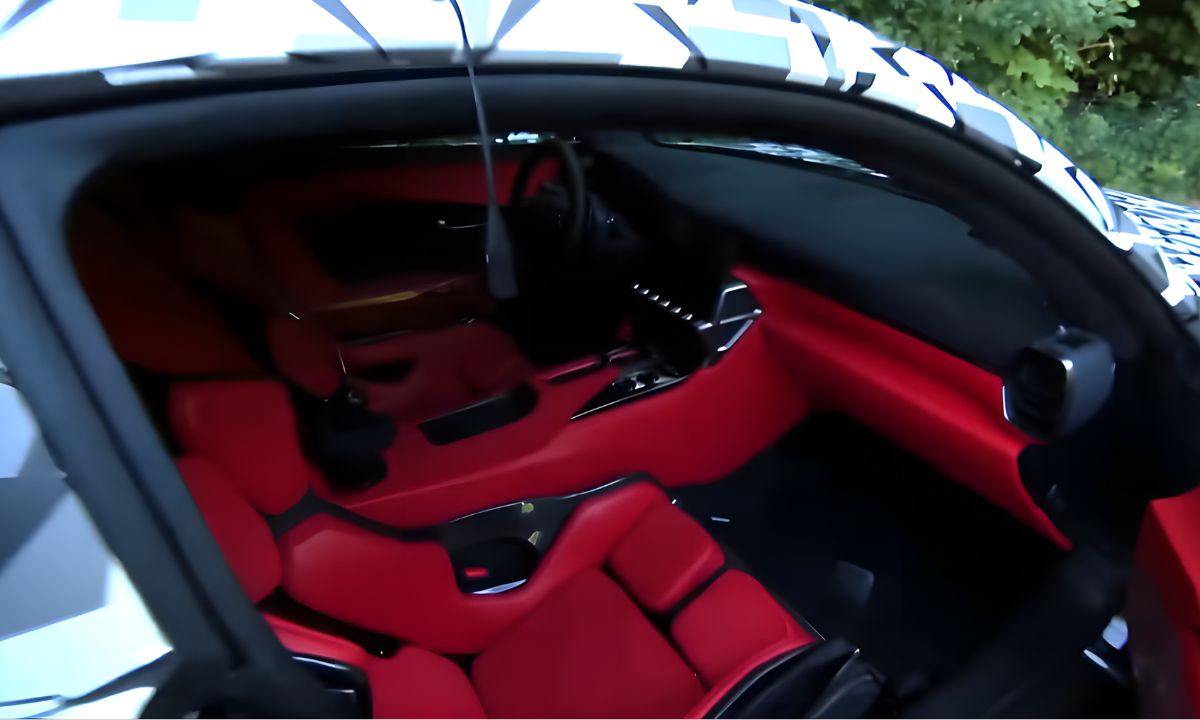The automotive world got its first glimpse inside Lexus’ highly anticipated LFR supercar at the 2025 Goodwood Festival of Speed, where the mysterious prototype made its official debut alongside thunderous V8 exhaust notes that confirm what enthusiasts have hoped for years.
Interior Design Philosophy Unveiled
The supercar has a predominantly red cabin with carbon bucket seats, marking a dramatic departure from Lexus’ traditional luxury aesthetic. The production-ready interior showcases a race-inspired design philosophy that prioritizes driver engagement over conventional comfort amenities.
Carbon fiber elements dominate the cabin architecture, with exposed weave patterns visible throughout the dashboard and door panels. The bucket seats feature integrated harness pass-throughs and aggressive side bolsters designed to keep occupants secure during high-performance driving scenarios.
Driver-Focused Cockpit Layout
The LFR’s interior reveals a minimalist approach that eliminates unnecessary distractions. Digital displays replace traditional analog gauges, while the center console houses essential controls within easy reach of the driver’s position. This setup reflects lessons learned from Toyota’s Gazoo Racing motorsports program.
Steering wheel design emphasizes functionality over luxury, featuring a flat-bottom configuration with integrated controls for various vehicle systems. The paddle shifters appear oversized compared to typical luxury car applications, suggesting a transmission system designed for rapid gear changes under extreme conditions.
Sound Engineering Excellence
It sounds like the Lexus LFR has a V8 with something else going on, potentially a hybrid situation, based on recordings from the Goodwood hill climb. The exhaust note combines deep V8 rumbles with subtle hybrid system contributions, creating a distinctive acoustic signature that distinguishes the LFR from traditional supercars.
The deep, rumbling exhaust sound heard during its Goodwood Hill run lends credence to reports of a twin-turbo V8 hybrid setup for the Lexus supercar. This powertrain combination promises both immediate throttle response and sustained high-rpm performance characteristics.
Powertrain Specifications and Performance
The new halo model will likely be powered by a hybridized V8 with nearly 800 hp, easily outperforming the iconic LFA. This represents a significant increase over the previous LFA’s 552 horsepower V10 configuration, positioning the LFR as a legitimate competitor to European supercars.
Prior reports have said that this car could deliver as much as 900 horsepower, with 700 or so coming from a gas V8 and the rest from a hybrid system. The hybrid component provides instant torque delivery while the V8 maintains the emotional connection that enthusiasts demand from high-performance machinery.
Racing Heritage Integration
Lexus brought the new LFR supercar to the Goodwood Festival of Speed, where it went up the famous hill alongside its Toyota-badged race car counterpart. This parallel development approach ensures that racing technology directly influences road car engineering.
The interior’s design language reflects this motorsports connection through strategic use of lightweight materials and ergonomic considerations developed through track testing. Carbon fiber construction extends beyond aesthetic elements to provide structural rigidity while reducing overall vehicle weight.
Production Timeline and Market Positioning
Current signs indicate that the car will be unveiled either late this year or in 2026, with production expected to begin shortly after the official reveal. This timeline positions the LFR to compete directly with established supercar manufacturers during a period of significant market evolution.
The LFR represents Lexus’ commitment to maintaining internal combustion engine performance while incorporating hybrid technology for enhanced efficiency and power delivery. This approach addresses environmental concerns without sacrificing the visceral driving experience that defines the supercar segment.
Technology Integration and User Experience
Modern supercar buyers expect sophisticated technology integration, and the LFR’s interior suggests comprehensive connectivity features. Digital displays provide real-time performance data while maintaining visual clarity during aggressive driving situations.
The cabin design balances luxury expectations with performance requirements, creating an environment that functions equally well on public roads and private tracks. This versatility represents a key differentiator in the competitive supercar market.
Market Impact and Competition
The street-legal LFR will get a twin-turbocharged V8 that’s supplemented with some kind of hybrid system, positioning it uniquely among supercars that increasingly rely on pure electric power or traditional combustion engines without hybrid assistance.
The LFR’s approach combines traditional supercar DNA with modern efficiency requirements, potentially influencing how other manufacturers approach future performance vehicle development. This balance between heritage and innovation represents Lexus’ strategy for maintaining relevance in an evolving automotive landscape.
Design Philosophy and Brand Identity
The interior reveal demonstrates Lexus’ evolution from luxury comfort to performance-focused engineering. Red leather and carbon fiber combinations create visual drama while maintaining functional superiority over purely aesthetic design choices.
This transformation reflects broader changes within Toyota’s performance division, where racing experience directly influences consumer product development. The LFR serves as a flagship demonstration of these capabilities across multiple vehicle categories.
Frequently Asked Questions
Q: When will the Lexus LFR be available for purchase? A: Current signs indicate that the car will be unveiled either late this year or in 2026, with production expected to follow shortly after the official reveal. Lexus hasn’t announced specific availability dates or pricing information.
Q: How much horsepower will the LFR produce? A: The new halo model will likely be powered by a hybridized V8 with nearly 800 hp, though some reports suggest as much as 900 horsepower, with 700 or so coming from a gas V8 and the rest from a hybrid system.
Q: What makes the LFR’s interior different from other Lexus models? A: The supercar has a predominantly red cabin with carbon bucket seats, representing a dramatic shift toward race-inspired design rather than traditional luxury comfort. The interior prioritizes driver engagement and performance functionality.
Q: Will the LFR sound like a traditional V8 supercar? A: The deep, rumbling exhaust sound heard during its Goodwood Hill run lends credence to reports of a twin-turbo V8 hybrid setup, suggesting it will maintain the emotional appeal of traditional V8 supercars while incorporating hybrid technology.
Also read: Beyond the Hype: The Ferrari 12Cilindri Spider as a True Grand Tourer – Deanoslawnsandproperties
